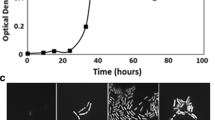Abstract
A microbial cyanide sensor was prepared, consisting of immobilizedSaccharomyces cerevisiae and an oxygen electrode. When the electrode was inserted into a solution containing glucose, the respiration activity of the microorganisms increased. The change in the respiration activity is monitored with the oxygen electrode. When cyanide is added to the sample solution, the electron transport chain reaction of the respiration system in the mitochondria is inhibited, resulting in a decrease in respiration. The inhibition is caused by cyanide binding with respiration enzymes such as the cytochrome oxidase complex in the mitochondrial inner membrane. Therefore, the cyanide concentration can be measured from the change in the respiration rate. When the sensor was applied to a batch system at pH 8.0 and 30°C, the cyanide calibration curve showed linearity in the concentration range between 0.3 μM and 150 μM CN-.
Similar content being viewed by others
References
Franson, M. A., ed. (1980),Standard Methods for the Examination of Water and Wastewater, 15th ed., American Public Health Association, Washington, DC.
Eeden, C. H. van and Jong, A. W. de. (1985),Z. Lebensm. Unters. Forsch. 181, 412–416.
Frant, M. S., Ross, J. W., and Riseman, J. H. (1972),Anal. Chem. 44, 2227–2230.
Fonong, T. (1987),Analyst 112, 1033–1035.
Mattiasson, B. and Mosbach, K. (1977),Biotechnol. Bioeng. 19, 1643–1651.
Mattiasson, B., Rieke, E., Munecke, D., and Mosbach, K. (1979),J. Solid-Phase. Biochem. 4, 263.
Groom, C. A. and Luong, J. H. T. (1991),J. Biotechnol. 21, 161–172.
Karube, I., Matsunaga, T., Mishuda, S., and Suzuki, S. (1977),Biotechnol. Bioeng. 19, 1535–1547.
Hikuma, M., Suzuki, H., Yasuda, T., Karube, I., and Suzuki, S. (1979),Europ. J. Appl. Microbiol. Biotechnol. 8, 289–297.
Karube, I. and Nakanishi, K. (1993),Current Opinion in Biotechnology 5, 54–59.
Karube, I. and Nakanishi, K. (1994),IEEE Engineering in Medicine and Biology 13.3, 365–374.
Karube, I. and Suzuki, M. (1990), inBiosensor, Cass, A. E. G., ed., IRL, Oxford, pp. 155–170.
Zollner, H. (1989),Handbook of enzyme inhibitors, VCH Verlagsgesellschaft, Weinheim, Germany, pp. 273,274.
Author information
Authors and Affiliations
Rights and permissions
About this article
Cite this article
Nakanishi, K., Ikebukuro, K. & Karube, I. Determination of cyanide using a microbial sensor. Appl Biochem Biotechnol 60, 97–106 (1996). https://doi.org/10.1007/BF02788064
Received:
Accepted:
Issue Date:
DOI: https://doi.org/10.1007/BF02788064




